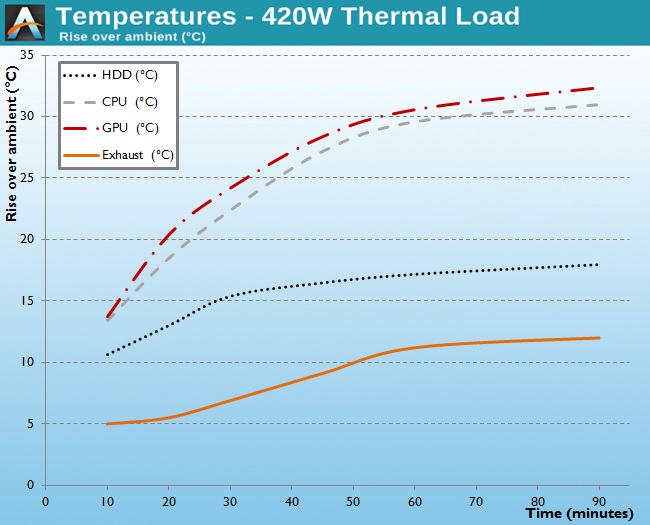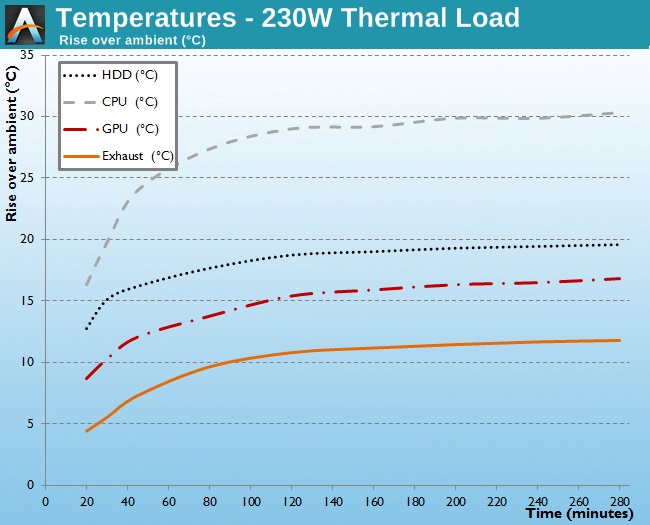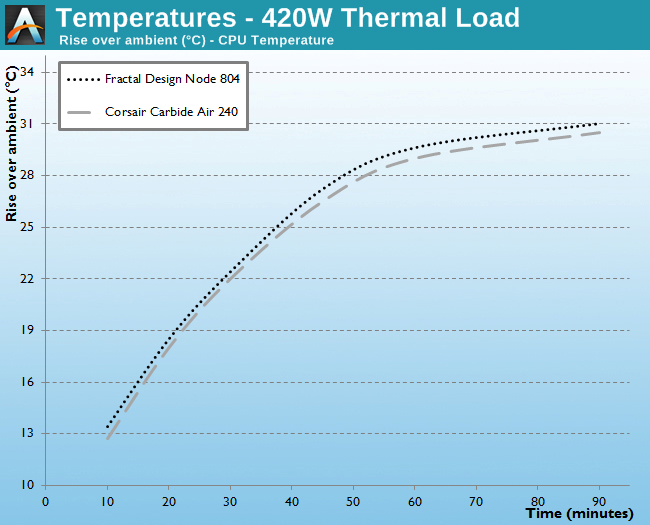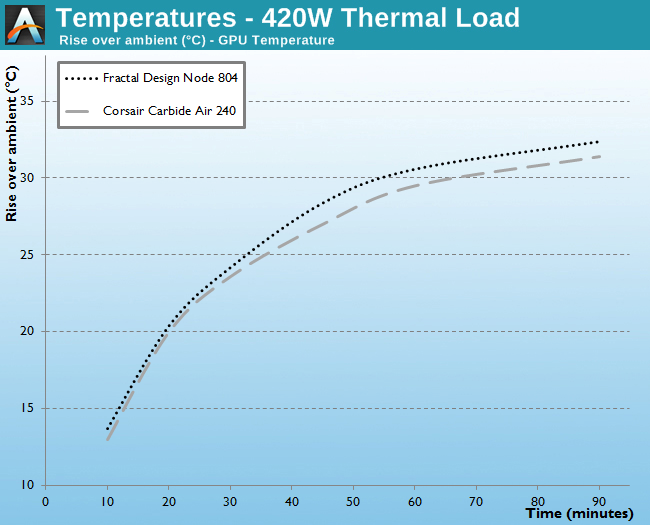Fractal Design Node 804 Case Review
by E. Fylladitakis on February 18, 2015 9:00 AM EST- Posted in
- Cases/Cooling/PSUs
- MicroATX
- Fractal Design
Test Setup
Professional testing requires the emulation of real-world situations but with repeatable results; thus, a perfectly controllable test setup and environment are required, especially for comparable results. Testing the thermal performance of any case with a typical real-world setup technically limits the comparability of the results to this setup alone, as an active system interacts with its environment and the change of a single component would alter myriads of variables. For our case reviews, we developed synthetic loads that emulate the thermal output of real systems, but these are passive, steady and quantifiable loads. This allows us to test the thermal capabilities of the case alone, as if it would have to deal with the entire thermal load by itself, regardless of what system an end user might install in it.
Laboratory data loggers are used to monitor the PT100 sensors and control the safety relays, which are fully accessible via our custom software. We have created three such loads, and we'll use the Micro-ATX load for this case. The Micro-ATX version simulates a 180W CPU, 40W VRM, 20W RAM, and 1 × 120W GPU card thermal load. Finally, two 3.5" HDD dummy loads have also been installed, with each of them converting 30W of electrical power to thermal. Note that the total load is generally more important than the individual elements, and the total thermal load of the Micro-ATX test setup is up to 420 Watts. As such, the thermal load is very high and only the best of cases will be able to handle it for more than a few minutes. For comparison purposes, we are also performing a test with a thermal load of 230W by reducing the CPU load to 90W, removing one disk load and using a low-profile, 50W version GFX load.
Thermal testing is performed with all of the case's stock fans operating at maximum speed. Standard noise testing has been performed with a background noise level of 30.4dB(A). Advanced noise testing is also being performed, in order to assess the ability of the case to dampen the noise of the components installed inside it. This includes the installation of two noise-generating sources (strong fans) inside the case, one positioned approximately over the first expansion slot and one over the CPU area, which generate ≈ 44.2 dB(A) when unobstructed. During the advanced noise test, all stock cooling options of the case are disabled.
Results and Discussion
Considering the size and type of the Fractal Design Node 804, its thermal performance is excellent. The stock cooling fans are slow and they have been clearly installed for the best possible acoustics performance, but they do a very good job at keeping the temperatures of the components within very acceptable levels. Unfortunately, we only have data from just one similar case to compare with at this point of time, the Corsair Carbide Air 240. Corsair's offering does have slightly better thermal performance, which however can be easily attributed to the inclusion of stronger cooling fans. The larger size and multiple vents of the Node 804 do cover most of that difference, but not entirely.
The stock cooling fans of the Node 804 have a maximum speed of just 1200RPM and their noise levels are very low, making them some of the quietest fans we have ever seen included with a case. They are not going to break any CFM air movement records, but they are remarkably quiet. Even at their maximum speed, only a soft humming sound can be heard from a distance of 1 meter, making them perfectly comfortable for everyday use.
As we expected from a case with so many openings, the Fractal Design Node 804 has no noise reduction capabilities whatsoever. The noise coming from our artificial source reached our instrumentation almost entirely unobstructed, meaning that any noise source installed inside the Node 804 will not be dampened at all to the perception of the user.















72 Comments
View All Comments
GreenMeters - Wednesday, February 18, 2015 - link
If it has a window, it's not a clean appearance.Zak - Wednesday, February 18, 2015 - link
Agree. Also the curved front makes it look like a small refrigerator.ddriver - Wednesday, February 18, 2015 - link
How much did the coca cola company pay for the placed ad? Nothing else to give a sense of scale?SunLord - Wednesday, February 18, 2015 - link
Give him a break he was hungry and ate his banana scaleanandreader106 - Wednesday, February 18, 2015 - link
Actually, that Coke can is open in that picture. I think it's safe to assume he consumed that as well.maximumGPU - Wednesday, February 18, 2015 - link
So much money Anand is begging to come back.Seriously though, it was previously explained why that was used.
I seriously doubt 1 pic of a coke can in a review of a micro atx case in a tech enthusiast website is gonna drive sales of the sugary drink..
geniekid - Thursday, February 19, 2015 - link
Man I really want a Coke right now.Lonyo - Wednesday, February 18, 2015 - link
Everyone knows how big a can of coke is, it's pretty much universal. It's a quite effective scale giving tool.JarredWalton - Wednesday, February 18, 2015 - link
We could use a kitty cat for scale:http://images.anandtech.com/doci/6516/Kitty.JPG
(Thanks to Ian for that. LOL)
just4U - Thursday, February 19, 2015 - link
What if it's Maine Coon or Norwegian? those kitties can get pretty damn big!